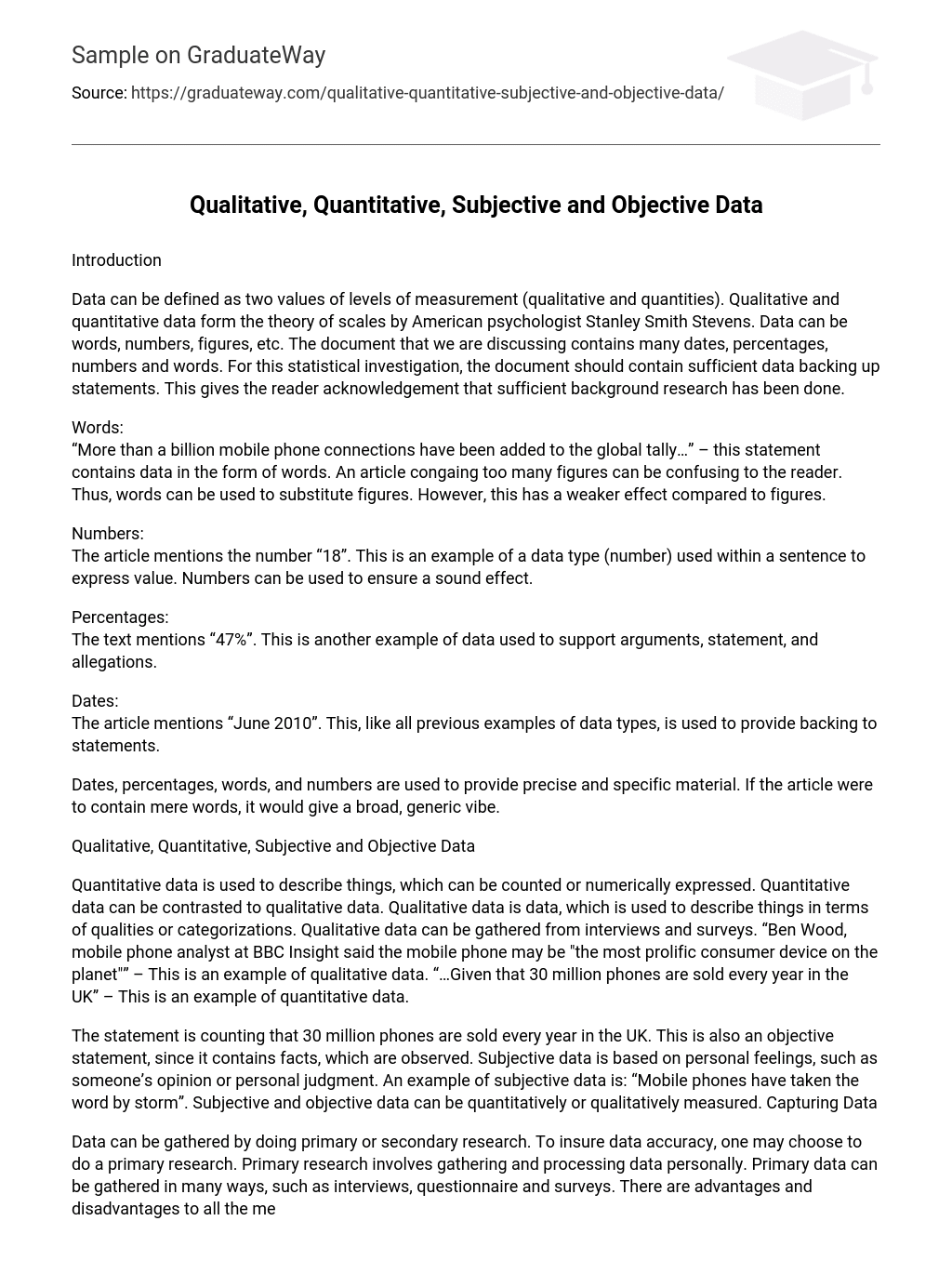Introduction
Data can be defined as two values of levels of measurement (qualitative and quantitative), as outlined in the theory of scales by American psychologist Stanley Smith Stevens. Data can take the form of words, numbers, figures, and other types of information. The discussed document encompasses a range of dates, percentages, numbers, and words. In order to conduct statistical investigations, it is important for the document to include ample data that supports statements. This ensures that the reader recognizes the presence of thorough background research.
Words can be used to substitute figures in order to make articles less confusing for readers. However, this has a weaker effect compared to using actual figures. An article states that over a billion mobile phone connections have been added globally.
Numbers:
The article discusses the use of numbers in sentences to express value. It provides an example of the number “18” being used as a data type and mentions that numbers can be used to create sound effects.
Percentages:
The text refers to “47%”. This is yet another instance of data being utilized to bolster arguments, statements, and claims.
Dates:
The article mentions “June 2010”. This date, like all previous examples of data types, serves as evidence for statements.
Dates, percentages, words, and numbers are utilized to offer detailed and specific information. Including only words in the article would create a general and generic impression.
Qualitative, quantitative, subjective, and objective data
Quantitative data is numerical and used to describe things, while qualitative data describes things in terms of qualities or categories. Qualitative data can be collected through interviews and surveys. For instance, Ben Wood, a mobile phone analyst at BBC Insight, stated that the mobile phone may be the most prolific consumer device globally. In contrast, a quantitative example is the fact that 30 million phones are sold every year in the UK.
The text mentions that the phone sales in the UK reach 30 million annually. This statement is objective as it presents verifiable information. In contrast, subjective data relies on personal beliefs or opinions. For example, a subjective statement would be: “Mobile phones are embraced worldwide.” Both subjective and objective data can be assessed using quantitative or qualitative methods. The act of collecting data is referred to as data capture.
There are two methods of collecting data: primary research and secondary research. Primary research involves personally gathering and processing data through interviews, questionnaires, and surveys. Each method has its own advantages and disadvantages.
Questionnaires can be administered at specific times and compared to previous ones, allowing for the creation of charts, graphs, and even forecasts based on the results. They can also be tailored for specific outcomes.
However, a drawback of questionnaires is the potential for misinformation if participants provide incorrect information. This can occur due to unclear questions or completing the survey hastily. For example, a questionnaire may inquire about recommending a phone to a friend; a participant might respond “yes” even if they wouldn’t actually recommend it. This limitation significantly affects the reliability of using questionnaires for data collection.
Another common method of capturing data is through surveys, typically in the form of feedback. Surveys can be placed on websites to reach a larger demographic, allowing for diverse feedback from individuals of various ethnic and racial backgrounds. This approach is valuable for studying the social feasibility of introducing new products or ideas.
Secondary research, also known as desk research, involves collecting information from existing primary sources. It is a suitable method when quick and cost-effective results are needed; however, it has disadvantages such as potential bias or inaccuracy in the primary research used. The Internet is commonly used for secondary research due to its vast amount of data, but finding reliable sources can be challenging. To overcome this challenge, books, newspapers, and magazines can be utilized to avoid potential issues. Despite the convenience of using the Internet and traditional sources like books and magazines, both carry the risk of outdated information. Newspapers, magazines, and television can also serve as sources for secondary research; caution must be exercised to prevent gathering biased or incorrect information. In comparison, primary research yields accurate results but is time-consuming while secondary research carries a higher risk of obtaining incorrect information but is more cost-effective.





